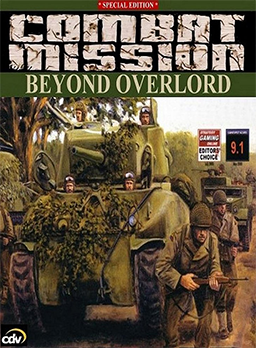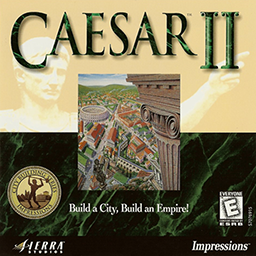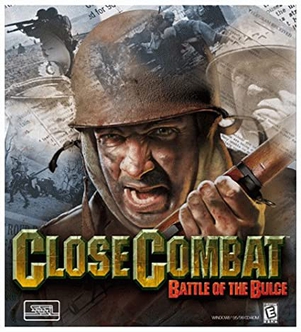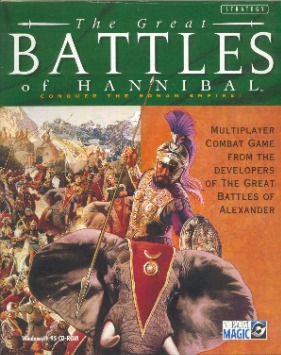
Sid Meier's Gettysburg! is a 1997 real-time wargame developed by Firaxis Games and published by Electronic Arts. It was designed by Sid Meier, and followed by Sid Meier's Antietam! in 1999.

Combat Mission: Beyond Overlord is a 2000 computer wargame developed and published by Big Time Software. It is a simulation of tactical land battles in World War II.

Caesar II is a 1995 video game of the Caesar video game series that takes place in Ancient Rome. It is the second game in the City Building series.

Lords of Magic is a turn-based strategy Microsoft Windows game designed for Windows 95/98 by Sierra On-Line. The game was intended to combine elements of Heroes of Might and Magic II and Lords of the Realm II. The special edition also contains the Legends of Urak quest pack, a set of five individual quests that revolve around stories unrelated to the main plot of the game.

Achtung Spitfire! is a 1997 computer wargame developed by Big Time Software and published by Avalon Hill. It is a turn-based air combat game taking place during the early half of World War II, including fixed-wing aircraft, air battles and operations by Luftwaffe, Royal Air Force and French Air Force in 1939–1943.

Battleground 9: Chickamauga is a 1999 computer wargame developed and published by TalonSoft. A simulation of conflict during the American Civil War, it is the ninth and final game in the Battleground series.

Avalon Hill's Squad Leader is a 2000 turn-based strategy video game developed by Random Games and published by Hasbro Interactive under the MicroProse label. It is a tie-in to Avalon Hill's board wargame Squad Leader.

The Operational Art of War I: 1939–1955 is a 1998 computer wargame developed and published by TalonSoft. Designed by Norm Koger, it covers military conflicts around the world at the operational level of war, between 1939 and 1955.

Air Warrior III, known as Air Warrior 3 in Europe, is a video game developed by Kesmai Studios and published by Interactive Magic and Midas Interactive Entertainment for Microsoft Windows in 1997. The game had been scheduled to be released in January 1998, before being pushed forward for December 15, 1997.

Close Combat: Battle of the Bulge, sometimes known as Close Combat IV: Battle of the Bulge, is a 1999 computer wargame developed by Atomic Games and published by Strategic Simulations Inc. (SSI). A simulation of the Battle of the Bulge during World War II, it is the fourth game in the Close Combat series. A remake, Close Combat: Wacht am Rhein, was released in 2008.
Battleground is a series of turn-based computer wargames developed and published by TalonSoft for Microsoft Windows between 1995 and 1999. Nine games were released in the series, each based on a different historical battle.
The Great Battles is a computer wargame series based on the Great Battles of History board game series by GMT Games. The three titles in the series—The Great Battles of Alexander, The Great Battles of Hannibal and The Great Battles of Caesar—were developed by Erudite Software and published by Interactive Magic.

The Great Battles of Alexander is a 1997 turn-based computer wargame developed by Erudite Software and published by Interactive Magic. Adapted from the GMT Games physical wargame of the same name, it depicts 10 of Alexander the Great's key conflicts, and simulates the interplay between Ancient Macedonian battle tactics and its rival military doctrines. Gameplay occurs at the tactical level: players direct predetermined armies on discrete battlefields, in a manner that one commentator compared to chess.

The Great Battles of Hannibal is a 1997 computer wargame developed by Erudite Software and published by Interactive Magic. Based on the board wargame SPQR, it is the sequel to The Great Battles of Alexander and the second game in the Great Battles computer wargame series.

Links LS 1998 is a golf video game developed and published by Access Software. It is part of the Links video game series, following Links LS (1996). It was released in 1997, and is the first game in the series to be published for Microsoft Windows. The game was well received, and was followed by Links LS 1999.

Steel Panthers II: Modern Battles is a 1996 computer wargame developed and published by Strategic Simulations. It is the sequel to Steel Panthers and the second entry in the Steel Panthers series. The game was designed by Gary Grigsby and Keith Brors.

North vs. South: The Great American Civil War is a 1999 computer wargame developed by Erudite Software and published by Interactive Magic.

Decisive Battles of WWII: The Ardennes Offensive is a 1997 computer wargame developed by Strategic Studies Group (SSG) and published by Strategic Simulations, Inc.

Steel Panthers III: Brigade Command 1939–1999 is a 1997 computer wargame developed and published by Strategic Simulations, Inc. It is the third game in the Steel Panthers series, following Steel Panthers (1995) and Steel Panthers II: Modern Battles (1996). Like its predecessors, it was designed by Gary Grigsby and Keith Brors.

Battle of Britain is a 1999 computer wargame developed and published by TalonSoft. It was designed by Gary Grigsby and Keith Brors.



















